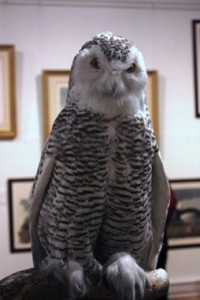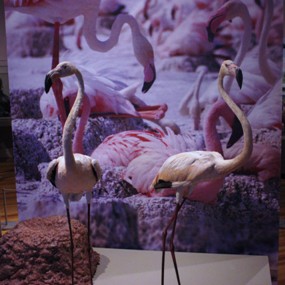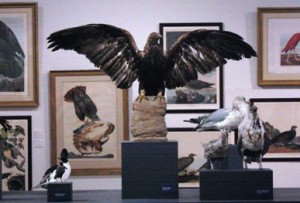Review by Seth Rogovoy
(PITTSFIELD, Mass.) – If you ever doubted that we share this planet with birds – or rather, that they share this planet with us, and that the interrelationship between birds and humans is imprinted in every aspect of our culture – indeed, that in order to understand what it is that makes us human, you need to reflect upon how we have imagined ourselves in the reflecting mirror of the avian species – then look no further than the extraordinary exhibition, Taking Flight: Audubon and the World of Birds, at Berkshire Museum now through June 17, 2012.
Curated by Berkshire’s director of interpretation Maria Mingalone, Taking Flight is the sort of interdisciplinary exhibition that Berkshire does best and that reflects Berkshire’s multifacted role as a museum of art and natural history. While the work of master wildlife artist John James Audubon is at the center of the exhibition – the show functions as an exhibition that places the naturalist in his cultural context, as such making it a terrific Audubon exhibition, boasting as it does an incredible display of original Audubon prints and artifacts – Audubon becomes merely a chapter, albeit quite a significant one, in the age-old story of man and bird, or bird and man.
The exhibition features more than thirty original hand-colored, life-size prints of birds from Audubon’s landmark The Birds of America, engraved by Robert Havell Sr. and Robert Havell Jr. from Audubon’s original watercolors, on loan from the Shelburne Museum, National Audubon Society, Arader Galleries, the Chapin Library at Williams College, and individual lenders.
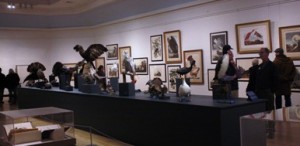 The prints, paired with almost as many bird specimens from the museum’s own collection, as well as loans from Harvard University, comprise the centerpiece of the exhibition. Works by Audubon’s contemporaries, such as Alexander Wilson, are also on view. If nothing else, the exhibition offers viewers a rare glimpse inside The Birds of America, the four-volume set made up of the meticulous engravings, which is now the most valuable book in the world; one recently sold at auction for $11.5 million.
The prints, paired with almost as many bird specimens from the museum’s own collection, as well as loans from Harvard University, comprise the centerpiece of the exhibition. Works by Audubon’s contemporaries, such as Alexander Wilson, are also on view. If nothing else, the exhibition offers viewers a rare glimpse inside The Birds of America, the four-volume set made up of the meticulous engravings, which is now the most valuable book in the world; one recently sold at auction for $11.5 million.
As Mingalone says, “Audubon was instrumental in changing the way birds were studied in the United States, and anywhere in the world for that matter, in the early nineteenth century. He gave the art of the naturalist a fresh context.”
But by surrounding Audubon (1785-1851) – the man, the artist, and his work – with corollary material, including other artistic representations of birds, including a Zuni owl figurine, a Peruvian ceramic jar in the shape of a bird, an ancient Greek terra cotta vessel with a bird decoration, a Chinese coat in bright blue satin embroidered with brilliant birds, insects, and animals, a Japanese bamboo basket in the shape of a swan, six Chinese woodblock prints of delicate birds dating from the 18th century, and a small selection of exquisite 19th century Japanese netsuke carved in the shape of birds, as well as early 20th century fashion items adorned with bird plumage, and other interpretive items, including a fascinating video visit to the studio of Walton Ford, the internationally renowned artist who is based in the Berkshires and whose work is essentially influenced by and a commentary upon Audubon’s, in which Ford discusses and demonstrates Audubon’s working methods, Mingalone has actually, unwittingly or not, done precisely for Audubon what she claims he did for the art of the naturalist – given Audubon himself a fresh context. It’s no surprise that at the exhibition’s opening, a board member of the National Audubon Society was overheard saying, “Now this is what an Audubon exhibit should look like.”
The exhibition also fulfills its educational mission by exploring the science of feathers and flight, the many different bird habitats, bird beaks, the highly-evolved senses of birds, bird intelligence, and bird behavior in a series of galleries containing a wide array of photographs and video, art, objects, specimens and samples of birds, eggs, and nests. The exhibition includes 110 varied bird specimens, from hummingbirds, blue jays, owls, and a crow to an ostrich, an eagle, and a hawk.
Along the way, the exhibition goes off on fascinating tangents into the history and technology of papermaking, engraving and lithography that contextualize the remarkable achievement of Audubon’s Birds of America.
No one can leave the exhibit without an enhanced appreciation for the diversity and wonder of birds, the resilient and beautiful creatures that have taken flight in our hearts and imaginations for millennia.
Several companion exhibitions serve to expand even further the world of man-bird dynamics as displayed in Taking Flight.
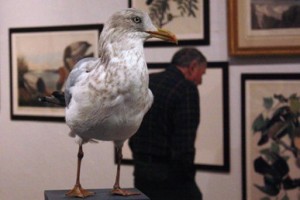 Painting America: The Hudson River School, featuring works by George Inness, Thomas Hill, Frederick Church and others makes the case for the 19th century American landscape painters collectively known as the Hudson River School whose portrayals of nature combined the reverence of prayer and devotion with the task of recording their luminous landscapes with the detailed care of naturalists.
Painting America: The Hudson River School, featuring works by George Inness, Thomas Hill, Frederick Church and others makes the case for the 19th century American landscape painters collectively known as the Hudson River School whose portrayals of nature combined the reverence of prayer and devotion with the task of recording their luminous landscapes with the detailed care of naturalists.
And Morgan Bulkeley: Bird Story is a solo exhibition by the Berkshire native whose busy, witty landscapes combine a sense of whimsy, fabulism, and pop. Read more about that exhibition here.
Berkshire Museum is open Monday through Saturday from 10 a.m. to 5 p.m. and Sunday noon to 5 p.m. For more information, visit Berkshire Museum or call 413.443.7171. Museum admission is $13 for adults and $6 for children. Members and children aged three and under enjoy free admission.
The Museum is located at 39 South Street on Route 7 in downtown Pittsfield. Berkshire Museum is the first public museum in Berkshire County, established by Zenas Crane in 1903 as a museum of art and natural history. Little Cinema is open year-round. Feigenbaum Hall of Innovation, Aquarium, Alexander Calder Gallery, and other exhibits are ongoing.

